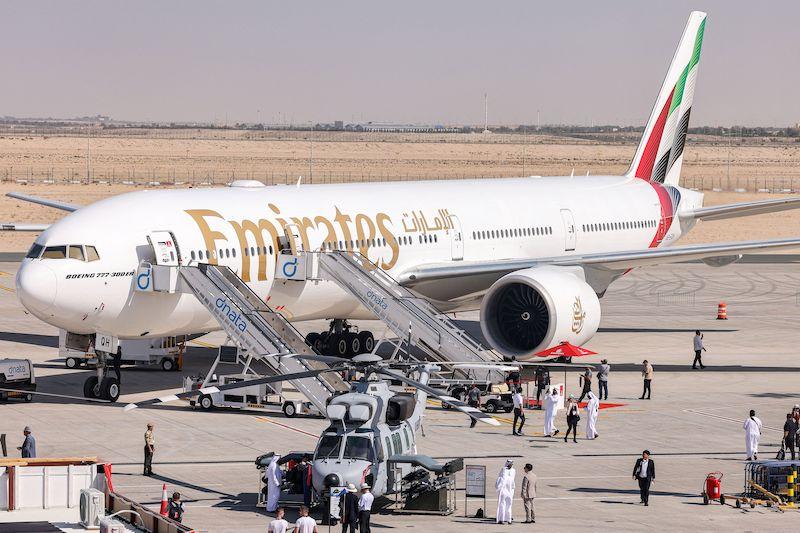
An Emirates Boeing 777-300ER on the tarmac here at Dubai World Central airport for this year's Dubai Airshow.
DUBAI—Dubai Airports is beginning the financial planning and design exercise for the expansion of Dubai World Central airport into a major hub, now that Emirates and flydubai have placed major additional aircraft orders that will bring Dubai International Airport beyond its current capacity limits and conceivable reserves.
The aircraft deliveries have “very aggressive timetables,” Dubai Airports CEO Paul Griffiths said at the Dubai Airshow. “There is no way we can produce [new] airport infrastructure at a rapid enough pace.” Griffiths believes the earliest possible time for a move from the current main airport—Dubai International Airport (DXB)—to Dubai World Central (DWC) is 2032.
“We would like them to build a hub twice the size of Dubai International with capability beyond that,” Emirates Airline President Tim Clark said. The new airport is needed “as soon as possible,” he added, though he estimated that it will take at least 10 years to build it.
Emirates announced firm orders for an additional 90 Boeing 777Xs and five 787s on top of existing commitments for 120 777Xs, 50 Airbus A350s and 30 787s. Also, flydubai has decided to enter into widebody operations for the first time with an order for 30 787-9s. It also has an earlier order in place for 136 737-8s.
DXB has processed 64.5 million passengers in the first nine months of the year. With a monthly average of around 7.6 million, the airport expects to handle well more than 85 million passengers in 2023, close to its current capacity limit of around 90 million.
DWC, which has one main runway, opened for cargo services in 2010, and the first passenger flights were operating by 2013. The current terminal has space for around 26 million passengers annually. The Dubai Airshow is also held at the site.
A new main airport at DWC would need to have an initial capacity of up to 150 million passengers annually, making it one of the largest such facilities in the world. Griffiths expects the airport to have either two or three runways when it opens. The potential move to DWC, planned for many years, has been delayed several times—not least due to pandemic-related setbacks.
“It has to be a modular design,” Griffiths said, referring to the terminal layout. “It has to be scalable without the scale,” allowing relatively short walking distances for passengers in spite of the overall large size of the facility. Also, “we cannot replicate the legacy approach.”
“We are all on the same page,” Clark said, referring to Dubai’s aviation stakeholders. Detailed planning for the new airport and its terminal had started about one year ago, as traffic had begun to come back sharply after the pandemic. Architects are working on detailed design. The government has been made aware, too, that the aviation community is pushing for the construction of the new airport, though an official go-ahead for the multi-billion-dollar investment has not yet been given.
Emirates earlier this week announced the construction of a $1 billion maintenance facility at DWC, comprising eight maintenance bays initially for aircraft up to Code F (Airbus A380) size.
In the meantime, Dubai Airports is therefore looking at a mix of measures to accommodate as many of the additional aircraft as possible at the current airport. “We cannot turn our back on what we have got,” Griffiths said.
Griffiths believes that DXB could be modified to expand capacity by another 20-30 million passengers through a mix of measures that include new technologies to accelerate passenger processing, enlarging existing terminals and redesigning gate space. But the airport cannot expand beyond its current perimeter. The facility has two parallel runways, but due to their proximity, independent operations are not possible.
Clark believes a lot can be done through changing the “internal configuration of the terminals.” More remote stands will also be introduced. Clark thinks that all the improvements can bring DXB to around 120 million annual passengers.
But the reserves will not be large enough to handle the expected growth. Therefore, Griffiths argues that part of the flydubai fleet should move to DWC and operate from that airport, even ahead of the transfer of all flights in the 2030s. The freed-up capacity at DXB could then be filled with larger aircraft, including flydubai's own new 787s.





